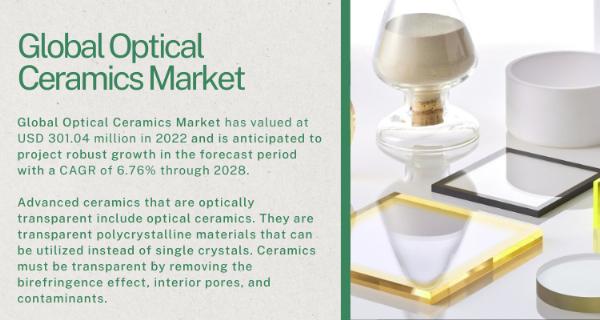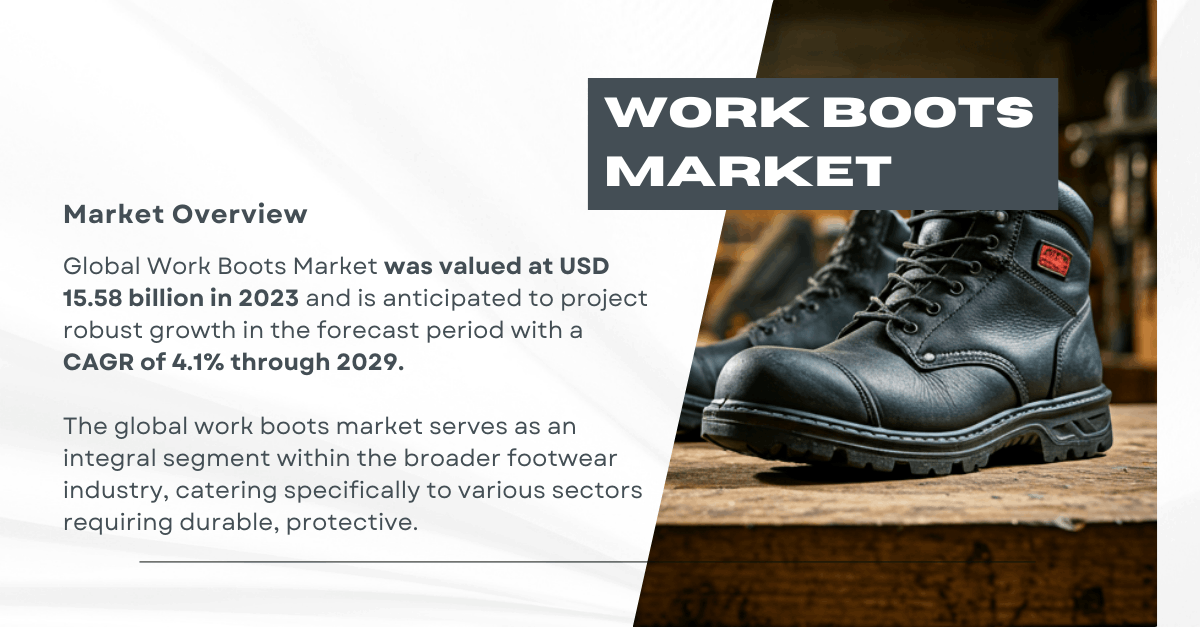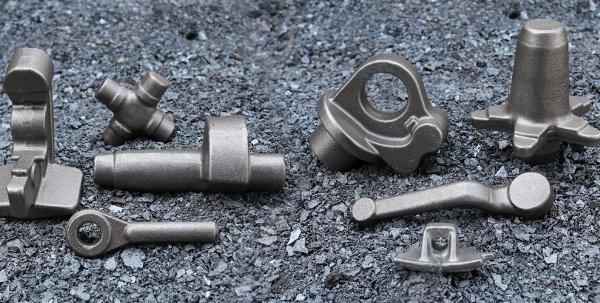Global Optical Ceramics Market Analysis Evaluating the Landscape and Growth Potential

Strong 8k brings an ultra-HD IPTV experience to your living room and your pocket.
According to TechSci Research report, “Optical Ceramics Market – Global Industry Size, Share, Trends, Competition Forecast & Opportunities, 2028”, the Global Optical Ceramics Market stood at USD 301.04 million in 2022 and is anticipated to grow with a CAGR of 6.76% in the forecast period, 2023-2028. The initiatives taken by the government based on Optical Ceramics have led to favorable market conditions for the Global Optical Ceramics Market. Several factors contribute to the growth of various Optical Ceramics products.
The National Science Foundation (NSF) offers various funding opportunities for research related to ceramics. These opportunities cover a wide range of ceramic materials, including optical ceramics, and aim to support innovative research in this particular field. By providing financial support, the NSF encourages scientists and researchers to explore new advancements and breakthroughs in the realm of optical ceramics, ultimately driving progress and innovation in this area.
In line with the significance of the ceramics industry, New York Governor Hochul recently announced her support for Corning Incorporated's substantial investment of $139 million. This investment aims to expand and strengthen Corning's operations in the Finger Lakes region.
As a major player in the ceramics industry, Corning's commitment to growth and development has the potential to greatly influence the optical ceramics market. By investing in research, development, and production facilities, Corning is poised to contribute to the advancement of optical ceramics technology and its applications. Looking beyond the private sector, the Office of Naval Research is focusing its efforts on the realization of low-temperature ceramics fabrication. This research direction is driven by the objective of developing less expensive ceramic materials.The implications of such advancements extend to the production of optical ceramics, potentially making them more affordable and accessible to a broader range of industries and applications. By exploring innovative fabrication techniques and materials, the Office of Naval Research aims to contribute to the overall progress of the ceramics industry, including the field of optical ceramics.
Furthermore, the United States Geological Survey recently released a list of 50 mineral commodities that are deemed critical to the U.S. economy and national security. Although the specific inclusion of materials used in optical ceramics is not specified, the release of such a list underscores the strategic importance of mineral resources. This acknowledgment highlights the potential impact on the supply chain for optical ceramics. Ensuring a stable and secure supply of essential minerals is crucial for the uninterrupted production and advancement of optical ceramics, which play a vital role in various technological applications.
Browse over XX market data Figures spread through XX Pages and an in-depth TOC on "Global Optical Ceramics Market” @ https://www.techsciresearch.com/report/optical-ceramics-market/4092.html
One of the main factors propelling the optical ceramics market is the continuous advancements in technology. These advancements include the development of new products that leverage low-cost and advanced technologies, thereby driving the expansion of this sector. For instance, the increased usage of optical ceramics in spectacles, aerospace & defense, energy, and electrical & electronics sectors has further contributed to the market growth.
Furthermore, technological improvements and inventions in the military and security industry have created a higher demand for advanced materials and technologies. This demand has been fueled by the increasing expenditure in the defense sector, which has become a significant driver for the optical ceramics market. As a result, research and development activities in the field have been intensified, leading to even more innovation and growth in the industry.
Global Optical Ceramics Market is segmented into material type, application, end-user, regional distribution, and company
Based on its end user, the Aerospace & Defense segment held the largest share of the market. Optical ceramics, known for their exceptional properties, are extensively used as a superior alternative to traditional glass lenses in various applications. For instance, they are widely employed in headlamp systems and aircraft windows, offering enhanced durability and performance.
These advanced ceramics also play a crucial role as essential components in solar panels mounted on space-based platforms. This enables uninterrupted power supply during eclipses or when the sun sets. Furthermore, optical ceramics exhibit remarkable thermal shock resistance, making them highly suitable for use in fire extinguishers.
Specifically, in situations where high-pressure oxygen or nitrogen is released through a nozzle, these ceramics act as protective layers on ceramic tiles. These tiles are deployed in areas prone to fire hazards due to friction caused by heat radiation from burning materials like oil or fuel oil. The increasing demand for optical ceramics from various end-use industries, including the automotive sector, has resulted in significant investments by companies operating within these domains.
Based on region, the Asia Pacific segment is expected to grow during the forecast period. The region is anticipated to witness substantial growth in the optical ceramics market due to the increasing demand from various end-use industries. The aerospace and defense sector, electronics industry, and energy and power sector are among the key drivers of this growth. The rising population in China and India is expected to further fuel the demand for optical ceramics in building structures, automobiles, and consumer appliances, among others.
Moreover, the region's growth is also supported by factors such as the rising disposable income of the population and government initiatives towards infrastructure development. These factors are projected to drive the expansion of the optical ceramics industry over the forecast period. In terms of geographical distribution, Europe accounted for a significant share of the global optical ceramics market. This can be attributed to the high consumption volumes generated by major end-use industries such as aerospace and defense, as well as automotive applications in countries like Germany, the UK, Italy, and France. These countries are expected to drive the regional growth of the optical ceramics market in Europe.
Similarly, North America has also made a significant contribution to the industry's growth. The increased military spending and growing investments by companies like Boeing Co. and Lockheed Martin Corp. have played a pivotal role in driving the demand for optical ceramics in this region.
Major companies operating in the Global Optical Ceramics Market are:
- CeraNova Corporation
- Ceramtec GmbH
- Surmet Corporation
- Schott AG
- Coorstek Corporation
- Murata Manufacturing Co. Ltd.
- Konoshima Chemicals Co. Ltd.
- Kyocera Corporation
- Saint-Gobain S.A.
- Ceradyne Inc.
Download Free Sample Report @ https://www.techsciresearch.com/sample-report.aspx?cid=4092
Customers can also request for 10% free customization on this report
“Growing application of Optical Ceramics in various end-user industries are key drivers of the Optical Ceramics market. Growth in the competitive landscape and the presence of well-established companies in the market who are dedicated to enhancing their productivity of Optical Ceramics with every passing year are anticipated to register an impressive growth in Global Optical Ceramics Market in the forecast period.,” said Mr. Karan Chechi, Research Director with TechSci Research, a research-based management consulting firm.
“Optical Ceramics Market By Material Type (Sapphire, Phosphor, Alumina, Selenide, Oxynitride, Spinel, Others), By Application (Active Devices & Passive Devices), By End User (Optics & Optoelectronics, Aerospace & Defense, Others), By Region, By Competition Forecast & Opportunities, 2018-2028F”, has evaluated the future growth potential of Global Optical Ceramics Market and provides statistics & information on market size, structure and future market growth. The report intends to provide cutting-edge market intelligence and help decision makers take sound investment decisions. Besides, the report also identifies and analyzes the emerging trends along with essential drivers, challenges, and opportunities in the Global Optical Ceramics Market.
You may also read:
Packaging Adhesives Market- Crafting Connections in a USD 14.34 Billion Industry
Oxo Alcohol Market - Evolution and Dynamics in USD 11.23 Billion Industry
Global Silica Sand Market - Quartz to Quality in USD 22.68 Billion Industry
Silicon Nitride Market Rising Demand for Corrosion-proof and Abrasion-resistant Solutions
Medical Foam Market Softness and Durability Combined in a USD 25 Billion Market
Table of Content-optical Ceramics Market
- Product Overview
1.1. Market Definition
1.2. Scope of the Market
1.2.1. Markets Covered
1.2.2. Years Considered for Study
1.2.3. Key Market Segmentations
- Research Methodology
2.1. Objective of the Study
2.2. Baseline Methodology
2.3. Key Industry Partners
2.4. Major Association and Secondary Sources
2.5. Forecasting Methodology
2.6. Data Triangulation & Validation
2.7. Assumptions and Limitations
- Executive Summary
3.1. Overview of the Market
3.2. Overview of Key Market Segmentations
3.3. Overview of Key Market Players
3.4. Overview of Key Regions/Countries
3.5. Overview of Market Drivers, Challenges, Trends
- Global Optical Ceramics Market Outlook
4.1. Market Size & Forecast
4.1.1. By Value
4.2. Market Share & Forecast
4.2.1. By Material Type (Sapphire, Phosphor, Alumina, Selenide, Oxynitride, Spinel, Others)
4.2.2. By Application (Active Devices & Passive Devices)
4.2.3. By End User (Optics & Optoelectronics, Aerospace & Defense, Others)
4.2.4. By Region
4.2.5. By Company (2022)
4.3. Market Map
4.3.1. By Material Type
4.3.2. By Application
4.3.3. By End User
4.3.4. By Region
- Asia Pacific Optical Ceramics Market Outlook
5.1. Market Size & Forecast
5.1.1. By Value
5.2. Market Share & Forecast
5.2.1. By Material Type
5.2.2. By Application
5.2.3. By End User
5.2.4. By Country
5.3. Asia Pacific: Country Analysis
5.3.1. China Optical Ceramics Market Outlook
5.3.1.1. Market Size & Forecast
5.3.1.1.1. By Value
5.3.1.2. Market Share & Forecast
5.3.1.2.1. By Material Type
5.3.1.2.2. By Application
5.3.1.2.3. By End User
5.3.2. India Optical Ceramics Market Outlook
5.3.2.1. Market Size & Forecast
5.3.2.1.1. By Value
5.3.2.2. Market Share & Forecast
5.3.2.2.1. By Material Type
5.3.2.2.2. By Application
5.3.2.2.3. By End User
5.3.3. Australia Optical Ceramics Market Outlook
5.3.3.1. Market Size & Forecast
5.3.3.1.1. By Value
5.3.3.2. Market Share & Forecast
5.3.3.2.1. By Material Type
5.3.3.2.2. By Application
5.3.3.2.3. By End User
5.3.4. Japan Optical Ceramics Market Outlook
5.3.4.1. Market Size & Forecast
5.3.4.1.1. By Value
5.3.4.2. Market Share & Forecast
5.3.4.2.1. By Material Type
5.3.4.2.2. By Application
5.3.4.2.3. By End User
5.3.5. South Korea Optical Ceramics Market Outlook
5.3.5.1. Market Size & Forecast
5.3.5.1.1. By Value
5.3.5.2. Market Share & Forecast
5.3.5.2.1. By Material Type
5.3.5.2.2. By Application
5.3.5.2.3. By End User
Note: IndiBlogHub features both user-submitted and editorial content. We do not verify third-party contributions. Read our Disclaimer and Privacy Policyfor details.





![Automotive Plastic Fasteners Market Forecast: [USD 2.74 Billion], [7.74%] Growth Rate Expected by 2028](https://indibloghub.com/public/images/courses/6799ab68c98b19867_1738124136.png)

